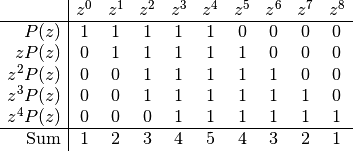kolzur_filter module¶
Version : 2017-03-31
Summary¶
Functions¶
_kz_coeffs(m, k) |
Calculate coefficients of the Kolmogorov–Zurbenko filter |
_kz_prod(data, coef, m, k[, t]) |
|
_kz_sum(data, coef) |
|
kz_filter(data, m, k) |
Kolmogorov-Zurbenko fitler |
kzft(data, nu, m, k[, t, dt]) |
Kolmogorov-Zurbenko Fourier transform filter |
kzp(data, nu, m, k[, dt]) |
Kolmogorov-Zurbenko periodogram |
sliding_window(arr, window) |
Apply a sliding window on a numpy array. |
Introduction¶
Numpy implementation of the Kolmogorov-Zurbenko filter
https://en.wikipedia.org/wiki/Kolmogorov%E2%80%93Zurbenko_filter
Todo
Implement the KZ adaptive filter.
Functions¶
-
_kz_coeffs(m, k)[source]¶ Calculate coefficients of the Kolmogorov–Zurbenko filter
Returns: A numpy.ndarrayof size k*(m-1)+1This functions returns the normlalised coefficients
 .
.Coefficients definition
A definition of the Kolmogorov–Zurbenko filter coefficients is provided in this article. Coefficients
 are
the coefficients of the polynomial function:
are
the coefficients of the polynomial function:
The
 coefficients are calculated by iterating over
coefficients are calculated by iterating over  .
.Calculation example for m=5 and k=3
Let us define the polynomial function

At
 , the coefficients
, the coefficients  are that of
are that of  ,
,
At
 , we want to calculate the coefficients of polynomial function
, we want to calculate the coefficients of polynomial function  , of degree 8.
First, we calculate the polynomial functions
, of degree 8.
First, we calculate the polynomial functions  ,
,  ,
,  and
and  and
then sum them.
and
then sum them.Let us represent the coefficients of these functions in a table, with monomial elements in columns:

At
 , we want to calculate the coefficients of polynomial function
, we want to calculate the coefficients of polynomial function  , of degree
12. We use the same representation:
, of degree
12. We use the same representation:
>>> c = _kz_coeffs(3, 1) >>> print(c) [ 0.33333333 0.33333333 0.33333333] >>> c = _kz_coeffs(3, 2) >>> print(c*3**2) [ 1. 2. 3. 2. 1.] >>> c = _kz_coeffs(5, 3) >>> print(c*5**3) [ 1. 3. 6. 10. 15. 18. 19. 18. 15. 10. 6. 3. 1.]
-
kz_filter(data, m, k)[source]¶ Kolmogorov-Zurbenko fitler
Parameters: - data (numpy.ndarray) – A 1-dimensional numpy array of size N. Any missing value should be set to
np.nan. - m (int) – Filter window width.
- k (int) – Filter degree.
Returns: A
numpy.ndarrayof size N-k*(m-1)Given a time series
 , the Kolmogorov-Zurbenko fitler is defined for
, the Kolmogorov-Zurbenko fitler is defined for
 by
by![KZ_{m,k}[X_t] = \sum_{s=-k(m-1)/2}^{k(m-1)/2} \frac{a_s^{m,k}}{m^k} \cdot X_{t+s}](_images/math/22a08f05fa61bc5e9d12825c1dd0432526f7458d.png)
Definition of coefficients
 is given in
is given in _kz_coeffs().- data (numpy.ndarray) – A 1-dimensional numpy array of size N. Any missing value should be set to
-
kzft(data, nu, m, k, t=None, dt=1.0)[source]¶ Kolmogorov-Zurbenko Fourier transform filter
Parameters: - data (numpy.ndarray) – A 1-dimensional numpy array of size N. Any missing value should be set to
np.nan. - nu (list-like) – Frequencies, length Nnu.
- m (int) – Filter window width.
- k (int) – Filter degree.
- t (list-like) – Calculation indices, of length Nt. If provided, KZFT filter will be calculated only for values
data[t]. Note that the KZFT filter can only be calculated for indices in the range [k(m-1)/2, (N-1)-k(m-1)/2]. Trying to calculate the KZFT out of this range will raise an IndexError. None, calculation will happen over the whole calculable range. - dt (float) – Time step, if not 1.
Returns: A
numpy.ndarrayof shape (Nnu, Nt) or (Nnu, N-k(m-1)) if t is None.Raises: IndexError – If t contains one or more indices out of the calculation range. See documentation of keyword argument t.
Given a time series
 , the Kolmogorov-Zurbenko Fourier transform filter
is defined for
, the Kolmogorov-Zurbenko Fourier transform filter
is defined for  by
by![KZFT_{m,k,\nu}[X_t] = \sum_{s=-k(m-1)/2}^{k(m-1)/2} \frac{a_s^{m,k}}{m^k} \cdot X_{t+s} \cdot
e^{-2\pi i\nu s}](_images/math/e50e378dcb3f282aa12ac69cc45be40f388a83f9.png)
- data (numpy.ndarray) – A 1-dimensional numpy array of size N. Any missing value should be set to
-
kzp(data, nu, m, k, dt=1.0)[source]¶ Kolmogorov-Zurbenko periodogram
Parameters: - data (numpy.ndarray) – A 1-dimensional numpy array of size N. Any missing value should be set to
np.nan. - nu (list-like) – Frequencies, length Nnu.
- m (int) – Filter window width.
- k (int) – Filter degree.
- dt (float) – Time step, if not 1.
Returns: A
numpy.ndarrayos size Nnu.Given a time series
 , the Kolmogorov-Zurbenko periodogram is defined by
, the Kolmogorov-Zurbenko periodogram is defined by![KZP_{m,k}(\nu) = \sqrt{\sum_{h=0}^{T-1} \lvert 2 \cdot KZFT_{m,k,\nu}[X_{hL+k(m-1)/2}] \rvert ^2}](_images/math/c721c18753572c8287facf0910e04b2103789170.png)
where
 is the distance between the beginnings of two successive intervals,
is the distance between the beginnings of two successive intervals,  being the
calculation window width of the
being the
calculation window width of the kzft()and the number of intervals.
the number of intervals.The assumption was made that
 , implying that the intervals overlap.
, implying that the intervals overlap.- data (numpy.ndarray) – A 1-dimensional numpy array of size N. Any missing value should be set to
-
sliding_window(arr, window)[source]¶ Apply a sliding window on a numpy array.
Parameters: - arr (numpy.ndarray) – An array of shape (n1, ..., nN)
- window (int) – Window size.
Returns: A
numpy.ndarrayof shape (n1, ..., nN-window+1, window).See also
Usage (1D):
>>> arr = np.arange(10) >>> arrs = sliding_window(arr, 5) >>> arrs.shape (6, 5) >>> print(arrs[0]) [0 1 2 3 4] >>> print(arrs[1]) [1 2 3 4 5]
Usage (2D):
>>> arr = np.arange(20).reshape(2, 10) >>> arrs = sliding_window(arr, 5) >>> arrs.shape (2, 6, 5) >>> print(arrs[0, 0]) [0 1 2 3 4] >>> print(arrs[0, 1]) [1 2 3 4 5]